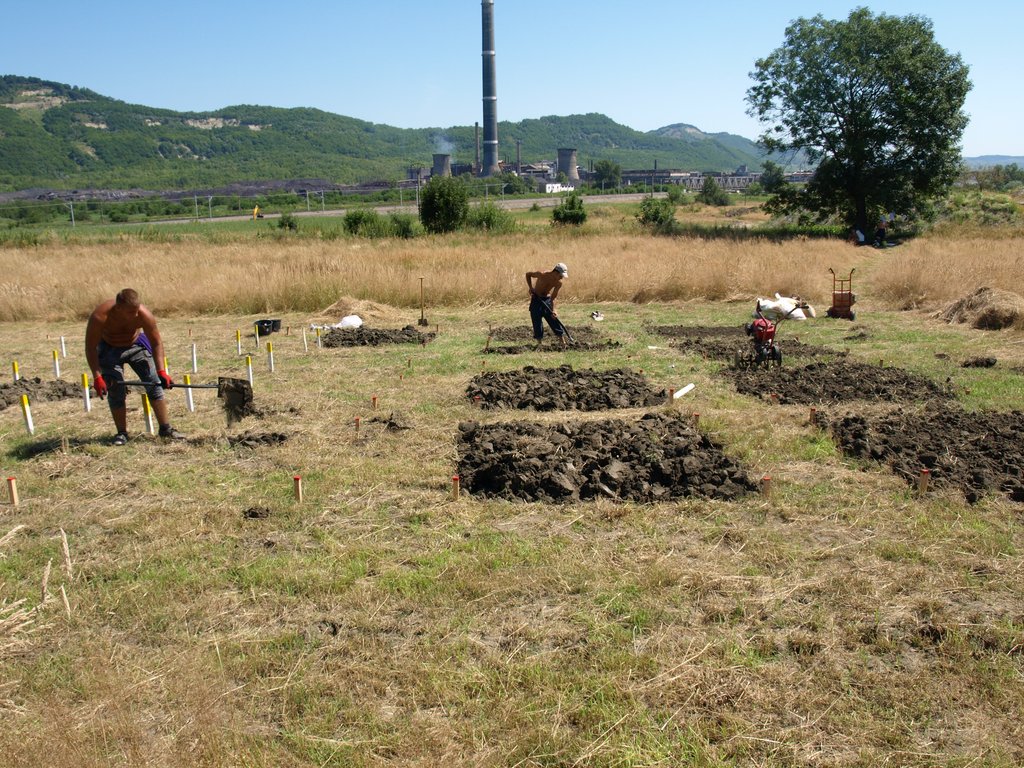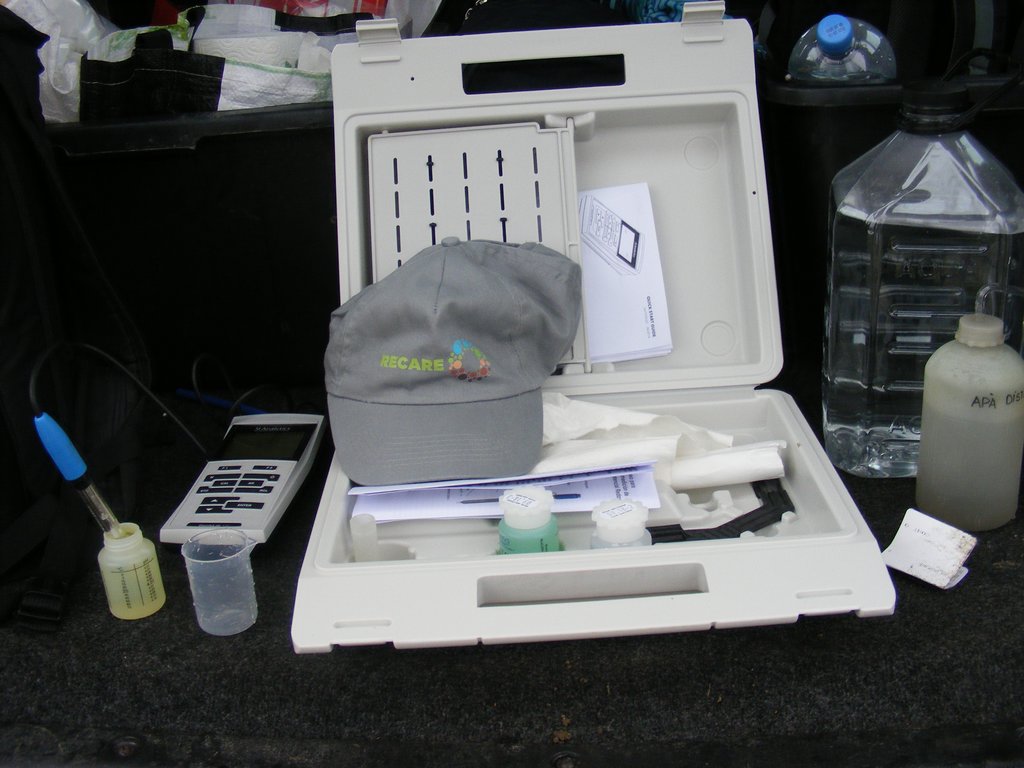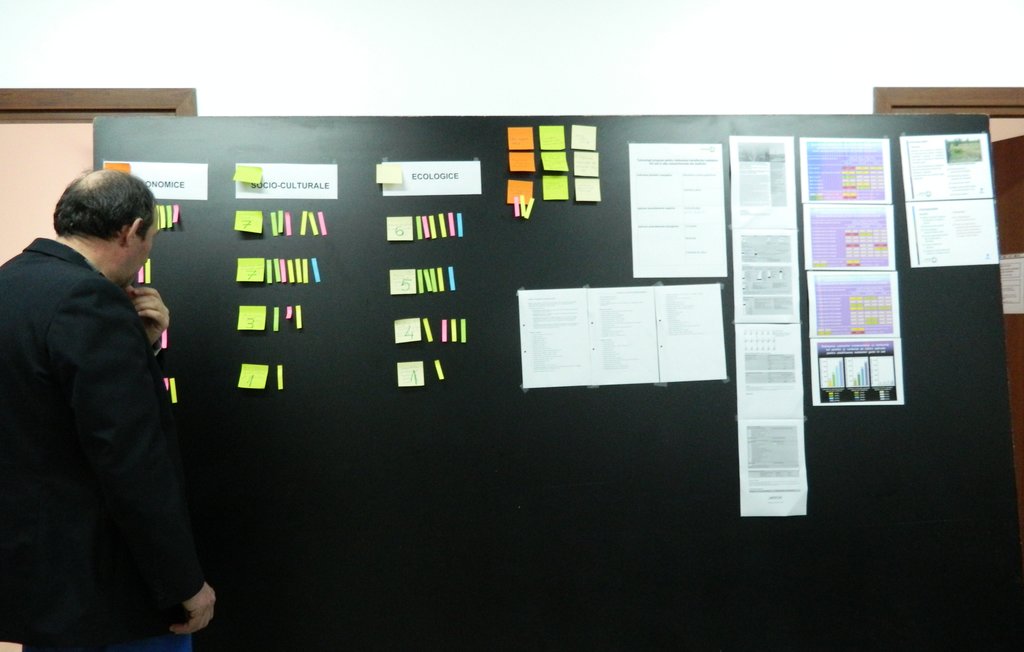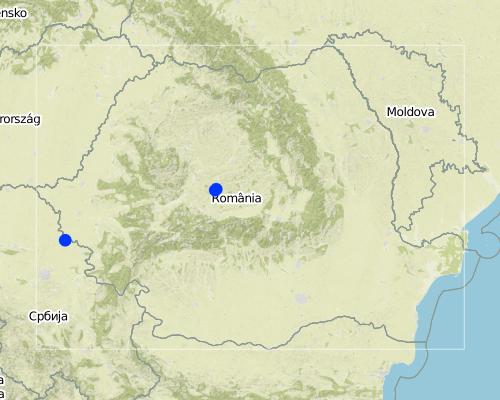Information and awareness raising for safe use of metal contaminated land [Румыния]
- Создание:
- Обновить:
- Составитель: Nicoleta Vrinceanu
- Редактор: –
- Рецензент: GWJ van Lynden
Cresterea gradului de constientizare si informarea populatiei in scopul utilizarii in siguranta a terenurilor din zonele contaminate cu metale grele
approaches_570 - Румыния
Просмотреть разделы
Развернуть все Свернуть все1. Общая информация
1.2 Контактные данные специалистов и организаций, участвующих в описании и оценке Подхода
1.3 Условия, регламентирующие использование собранных ВОКАТ данных
Когда были собраны данные (на местах)?
02/03/2015
Составитель и ответственный/-ые специалист(-ы) согласны с условиями, регламентирующими использование собранных ВОКАТ данных:
Да
2. Описание Подхода УЗП
2.1 Краткое описание Подхода
The aim of this Aprroach is to increase the awareness about the risk related to agricultural use of contaminated land and to present the appropriate technologies for sustainable use of contaminated land in order to reduce the transfer of contaminants into the food chain. The implementation of appropriate SLM will improve the soil and crop quality with positive effects on the quality of life for local community from contaminated area.
2.2 Подробное описание Подхода
Подробное описание Подхода:
The Case Study area is located in Sibiu County, around the most important factory for processing of non-ferrous ores – Copsa Mica. The main environmental damages in the area Copşa Mică (Romania) are caused by ore processing and this town was classified as an environmental disaster area. The main pollutants identified in this area were cadmium, copper, lead and zinc. According to data from LPIS provided by Sibiu County Center of Agency for Payments and Intervention in Agriculture (2012) the arable land represents 60.4% from total area (2818.6ha) being located mainly in bottomland. Grassland represents 34.9% from total area, that means 1627.3 ha. Orchards and vineyards represent a very small proportion from total cultivated area, only 2.3% (106 ha) and 2.4% (110.3 ha).
Large scale migration from urban to rural areas (village surrounding the Copsa Mica) took place after reducing the activities of industrial platform. In villages located in polluted area there are many small landowners. The lands are used as agricultural land and the products are used for own consumption. Also, due to both, low fertility of soil (as a result of contamination) and lack of financial resources, there are lands abandoned. The agricultural use of the land represents a risk for population health and also reduces the number of methods that could be used for remediation.
The aim of the approach was to increase the awareness about the risk related to agricultural use of contaminated land and to present the appropriate technologies for sustainable use of contaminated land in order to reduce the transfer of contaminants into the food chain. The implementation of appropriate SLM will improve the soil and crop quality with positive effects on the quality of life for local community from contaminated area.
During workshops stakeholders are informed about state of soil degradation from their area, about risk related to agricultural use of contaminated land. The researchers and SLM experts share their experience with land owners and land users related to sustainable measures for reducing the effects of soil contamination and together they select the measures to be tested. The production of biomass for non-food purpose has been tested as a potential solution to produce valuable biomass while remediating the soil. Immobilization of heavy metals in soil was agreed by the traditional land owners who want to keep the agricultural use for their land.
Land owners offer the plot for testing the new technology and researchers / SLM experts organised experimental field and presenting the results to land owners, local authority, farmers, students during information session (field day, workshop)
2.3 Фотографии, иллюстрирующие Подход
Общие замечания к фотографиям:
Activities for information and test the new technology selected by land users and experts
2.5 Страна/ регион/ место, где применялся Подход
Страна:
Румыния
Административная единица (Район/Область):
Sibiu county
Более точная привязка места:
Copsa Mica
Комментарии:
Both Copsa Mica and Axente Sever are located in highly contaminated area.
Map
×2.6 Даты начала и окончания реализации Подхода
Если год начала реализации Подхода достоверно неизвестен, дайте примерную оценку:
менее 10 лет назад (недавняя)
2.7 Тип Подхода
- в рамках проекта/ программы
2.8 Каковы цели/ задачи Подхода
The aim was to increase the awareness about the risk related to agricultural use of contaminated land and to present the appropriate technologies for sustainable use of contaminated land in order to reduce the transfer of contaminants into the food chain. The implementation of appropriate SLM will improve the soil and crop quality with positive effects on the quality of life for local community from contaminated area.
2.9 Условия содействующие применению Технологии/ Технологий в рамках Подхода или затрудняющие его
Социальные/ культурные/ религиозные нормы и ценности
- затрудняют
The traditional farmers want to preserve the agricultural use of land (crop production and grazing). Growing biofuel crops would require changing the land use for a long period of time.
Наличие/ доступность финансовых ресурсов и услуг
- затрудняют
Lack of financial resources of the land users. The financial inputs for implementation are considered high even if there are subsidies for energy crops.
Институциональные условия
- затрудняют
There are no interest for SLM on contaminated lands
Нормативно-правовая база (землевладение, права на земле- и водопользование)
- затрудняют
Due to the large number of owners and the division of the land into small plots there are difficulties with respect to the application of appropriate SLM.
Программные документы/ руководящие установки
- затрудняют
Although there are legal frameworks regarding pollution control there are no institutions responsible for the development and implementation of remediation measures. Also there are no clear legal descriptions of decision criteria for choosing the appropriate remediation actions.
Осведомленность в области УЗП, доступность технической поддержки
- затрудняют
Although there are known risks associated with soil contamination with heavy metals, landowners do not have enough information about SLM which could limit the transfer of metals into the food chain.
Рынки (для приобретения материалов и услуг, продажи продукции) и цены
- затрудняют
The energy crop market is not developed yet.
Объем работ, доступность рабочей силы
- содействуют
3. Участие и распределение ролей заинтересованных сторон
3.1 Заинтересованные стороны, участвующие в реализации Подхода и их роли
- местные землепользователи/ местные сообщества
land users, local authority, farmers
They participate in information sessions and one land user offered a plot to test new technologies for immobilization of heavy metals in soil.
- ученые-исследователи
Researchers - soil scientist, enviromental experts,
They share their experience in respect with risk related with agricultural use of land in contaminated area and appropriate SLM for limiting the transfer of heavy metals into food chain.
3.2 Участие местных землепользователей/ местных сообществ на разных стадиях реализации Подхода
| Участие местных землепользователей/ местных сообществ | Перечислите участников и опишите их вовлеченность | |
|---|---|---|
| инициирование/ мотивация | пассивное | Researchers organised information sessions (workshops and stakeholder meetings) for land owners, local authority, farmers, students. |
| планирование | интерактивное | Researchers and SLM experts organised participatory sessions with land owners, local authority, farmers, students in order to select the appropriate SLM Technology to be tested. |
| выполнение | интерактивное | Land owners offer the plot for testing the new technology and researchers and SLM experts organised experimental field and presenting the results to land owners, local authority, farmers, students during information session (field day, workshop) |
| мониторинг/ оценка | нет | |
| Research | нет |
3.3 Схема реализации (если имеется)
Описание:
NA
3.4 Принятие решений по выбору Технологии/ Технологий УЗП
Укажите, кто принимал решение по выбору применяемой Технологии/ Технологий:
- в основном землепользователи при поддержке специалистов по УЗП
Поясните:
Selection of appropriate SLM Technologies was made by land users, farmers and land owners suppoted by SLM specialists during participatory sessions.
Поясните на чём было основано принятие решений:
- анализ подробно описанного опыта и знаний по УЗП (принятие решений на основе подтвержденных фактов)
- результаты исследований
- личный опыт и мнения (незадокументированные)
4. Техническая поддержка, повышение компетенций и управление знаниями
4.1 Повышение компетенций/ обучение
Проводилось ли обучение землепользователей/ других заинтересованных лиц?
Да
Укажите, кто проходил обучение:
- землепользователи
Тип обучения:
- обмен опытом между фермерами
- опытные участки
- общие собрания
Рассматриваемые темы:
Status of soil degradation by heavy metal contamination. Risk related to agricultural use of contaminated land. Measures for reducing the transfer of contaminants into food chain.
4.2 Консультационные услуги
Есть ли у землепользователей возможность получать консультации?
Да
Укажите, где именно оказываются консультационные услуги:
- на полях землепользователей
4.3 Институциональная (организационная) поддержка
В ходе реализации Подхода были ли организованы новые институциональные структуры или поддержаны уже существующие?
- нет
4.4 Мониторинг и оценка
Являются ли мониторинг и оценка частью Подхода?
Да
Если да, будет ли данный документ использоваться для мониторинга и оценки?
Да
4.5 Научные исследования
Были ли научные исследования частью Подхода?
Да
Укажите темы исследований:
- экология
5. Финансирование и внешняя материальная поддержка
5.1 Годовой бюджет мероприятий по УЗП в рамках Подхода
Если точный годовой бюжет неизвестен, укажите примерный диапазон затрат:
- 2000-10000
Комментарий (например, основные источники финансирования/ ключевые доноры):
Research projects funding from National Research Fund and EU projects
5.2 Финансирование и внешняя материальная поддержка, предоставляемая землепользователям
Предоставлялась ли землепользователям финансовая/ материальная поддержка для применения Технологии /Технологий?
Да
Если да, укажите тип(-ы) поддержки, кто ее предоставил и условия предоставления:
Subsidies for energy crops
5.3 Субсидии на отдельные затраты (включая оплату труда)
- сельскохозяйственные
| Укажите, какие ресурсы были субсидированы | В какой степени | Опишите субсидии подробнее |
|---|---|---|
| семена | профинансированы частично | 173 US$ / ha - spring 2015 |
5.4 Кредитование
Предоставлялись ли в рамках Подхода кредиты на мероприятия УЗП?
Нет
5.5 Другие методы или инструменты стимулирования
Использовались ли другие методы или инструменты стимулирования для продвижения Технологий УЗП?
Нет
6. Анализ влияния и заключительные положения
6.1 Влияние Подхода
Сумел ли Подход расширить знания и возможности землепользователей в применении практик УЗП?
- Нет
- Да, немного
- Да, умеренно
- Да, существенно
Were highlighted risks of agricultural use of contaminated land and the possibilities of limiting the transfer of contaminants into the food chain by changing land use or by immobilizing metals in soil.
Сумел ли Подход привести к созданию новых рабочих мест/ к расширению возможностей получения дохода?
- Нет
- Да, немного
- Да, умеренно
- Да, существенно
Implementing the SLM could lead to high economic value of the crop (biomass fuel production, healthy crops, etc).
6.2 Основные причины, побуждающие землепользователей внедрять УЗП
- рост продуктивности
- рост прибыли (доходности) и рентабельности
- материальное стимулирование/ субсидии
The farmers recieved the subsidiy for energy crops.
6.3 Долгосрочная устойчивость мероприятий в рамках Подхода
Могут ли землепользователи самостоятельно (без внешней поддержки) продолжать применение того, что было реализовано в рамках Подхода?
- нет
Если нет или нет уверенности, объясните почему:
They need financial support to continue application of selected SLM.
6.4 Сильные стороны/ преимущества Подхода
| Сильные стороны/ преимущества/ возможности по мнению землепользователей |
|---|
| Receiving the knowledge tools to improve the quality of crops and offering the possibility to provide new products (from biofuel crops) on the market which increase the farm income. |
| Сильные стороны/ преимущества/ возможности по мнению составителя или других ключевых специалистов |
|---|
| Awareness raising about the risk related to agricultural use of contaminated land lead to increase the number of land users which want to implement appropriate SLM for contaminated land. |
6.5 Слабые стороны/ недостатки Подхода и пути их преодоления
| Слабые стороны/ недостатки/ риски по мнению землепользователей | Возможные пути их преодоления/снижения? |
|---|---|
|
Difficulties to continue the activities initiated without external financial input. |
Subsidies |
| Undeveloped energy crop market | Support for creating local or regional markets for energy crops |
| Слабые стороны/ недостатки/ риски по мнению составителя или ответственных специалистов | Возможные пути их преодоления/снижения? |
|---|---|
| Inadequate authorities' interest for SLM | The authorities have to provide help in order to meet the needs (support for poor land users) in order to implement SLM activities to change land uses or to adopt measures for reducing transfer of contaminants into the food chain. |
7. Справочные материалы и ссылки
7.1 Методы сбора/источники информации
- выезды на места, полевые обследования
- опросы землепользователей
- данные, собранные из отчетов и достоверных документов
7.2 Ссылки на опубликованные материалы
Название, автор, год публикации, ISBN:
Nicoleta Vrinceanu, Motelica, D.M., Dumitru, M., Eugenia GAMENŢ, Calciu, I., Veronica Tanase, Mihaela Preda (2008) – Assessment of Some Inorganic Additives Used for In-Situ Remediation of Heavy Metals Polluted Soils, Abstract book of The 1st European Conference on Remediation of Soil, sediment and Groundwater – Biological, Chemical and Physical Technologies, 21–23 october 2008, Amsterdam, Olanda, p.173.
Название, автор, год публикации, ISBN:
Comănescu, l., Nedelea, A., Paisa, M., 2010. Soil pollution with heavy metals in the area of Copșa Mică town – Geographical considerations, Metalurgia International XV 4, 81-85.
Название, автор, год публикации, ISBN:
Lăcătușu, R., Lăcătușu, A.R., 2010. Evolution of heavy metals pollution from Copșa Mică. Scientific Papers, UASVM Bucharest, Series A, LIII, 85-92.
Название, автор, год публикации, ISBN:
Petronela-Bianca Pavel, Puschenreiter, M., Wenzel, W.W., Elena Diacu, Barbu, C.H., Aided phytostabilization using Miscanthus sinensis × giganteus on heavy metal-contaminated soils, Science of the Total Environment 479–480 (2014) 125–131
7.3 Ссылки на материалы, доступные онлайн
Название/ описание:
Miscanthus giganteus - o solution for contaminated land
Адрес в сети Интернет:
http://www.tribuna.ro/stiri/actualitate/miscanthus-plantat-la-cop-sa-mic-a-inc-a-din-2007-51036.html
Название/ описание:
Miscanthus giganteus - the crops too expensive for romanian farmers
Адрес в сети Интернет:
http://www.tribuna.ro/stiri/eveniment/culturile-de-miscanthus-prea-scumpe-pentru-agricultorii-sibieni-76070.html
Название/ описание:
*** Annual Report of EPA Sibiu County. 2012. (in Romanian)
Адрес в сети Интернет:
http://apmsb.anpm.ro/upload/62681_Raport%20anual%20privind%20monitorizarea%20PIGCA%20pentru%20anul%202011.pdf
Ссылки и модули
Развернуть все Свернуть всеСсылки
Нет ссылок
Модули
Нет модулей







